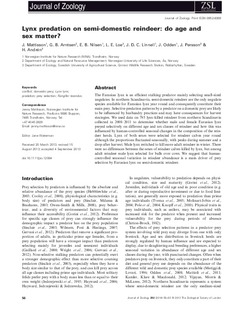Lynx predation on semi-domestic reindeer: do age and sex matter?
Mattisson, Jenny; Arntsen, Gustav Busch; Nilsen, Erlend Birkeland; Loe, Leif Egil; Linnell, John Durrus; Odden, John; Persson, J.; Andrén, H.
Journal article, Peer reviewed
Published version

View/
Date
2014Metadata
Show full item recordCollections
- Publikasjoner fra CRIStin - NINA [2397]
- Scientific publications [1423]
Abstract
The Eurasian lynx is an efficient stalking predator mainly selecting small-sized ungulates. In northern Scandinavia, semi-domestic reindeer are the only ungulate species available for Eurasian lynx year round and consequently constitute their main prey. Selective predation patterns by a predator on a domestic prey are likely to be influenced by husbandry practices and may have consequences for harvest strategies. We used data on 795 lynx-killed reindeer from northern Scandinavia collected in 2008–2011 to determine whether male and female Eurasian lynx preyed selectively on different age and sex classes of reindeer and how this was influenced by human-controlled seasonal changes in the composition of the reindeer herds. Lynx of both sexes were selected for reindeer calves year round although the proportions fluctuated seasonally, with peaks during summer and a drop after harvest. Male lynx switched to kill more adult reindeer in winter. There were no differences between the sexes of reindeer calves killed by lynx, but among adult reindeer male lynx selected for bulls over cows. We suggest that humancontrolled seasonal variation in reindeer abundance is a main driver of prey selection by Eurasian lynx on semi-domestic reindeer. conflict; domestic prey; Lynx lynx; predation; prey selection; Rangifer tarandus.